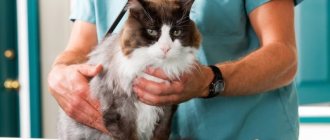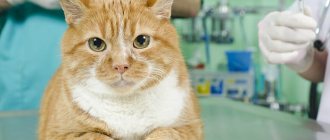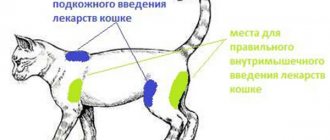14000Administration
Puberty in cats occurs at the age of 7-9 months. This means that the time has come when your pet’s body is ready to reproduce. And for those who do not plan to breed and adopt kittens, the time has come to think about methods to prevent reproduction.
Today, the most effective method is sterilization; it is safe for cats and solves a number of problems associated with hormonal changes that affect the character of the pet. Sterilization of cats using the laparoscopic method is a cavityless operation, the most gentle.
What is sterilization
The sterilization procedure itself is a surgical method of removing reproductive organs. It is carried out by the cavity method and laparoscopically , that is, through small incisions. The second is considered preferable, since the postoperative recovery period is much faster and easier.
Types of cat sterilization:
- removal of ovaries . After such an operation, the cat stops estrus;
- removal of the uterus and ovaries . It is believed that this laparoscopic operation is the most optimal from a medical point of view. It not only solves the issue of ridding Murka from pregnancy, but also has a positive effect on her health. Now you don’t have to worry about the occurrence of various inflammatory processes in the reproductive organs. Since both the uterus and ovaries have been removed, the cat is not at risk of such diseases.
Neutered cats live a normal life, just like their unsterilized cats.
© shutterstock
How is such an operation carried out?
- The cat is put under anesthesia.
- The surgical field is processed on the anterior wall of the abdomen - the hair is shaved off, and antiseptics are applied.
- In several places, punctures of the peritoneum are made with a special instrument (trocar).
- The abdominal cavity is filled with carbon dioxide to increase its volume.
- An endoscope inserted through punctures displays an image of the internal organs on the monitor.
- The cat's uterus and ovaries are removed using special instruments.
- The wounds are treated with the application of special threads or surgical plaster.
Optimal age for laparoscopic sterilization
There are so many doctors, so many opinions. This also applies to the issue of laparoscopic sterilization of cats. Some claim that such an operation can be done at any age and it is better to let the pet give birth at least once. Others, on the contrary, are categorical on this issue and insist that the owners must make a decision when the kitten reaches six months of age. That is, puberty has not yet occurred and the cat does not experience instinctive needs for motherhood.
In any case, it is better to consult a veterinarian and make a joint decision.
Choosing the age for castration
Recommended age of the animal: 6-8 months, until the cat’s first heat and the cat’s activity. Early castration is more effective than castration at a later age , when the genital organs and glands have completed their formation and the animal’s sexual behavior has already manifested itself.
If the operation is to be performed on an adult cat, then it is performed 2-3 months after the last heat.
In a young cat, only the ovaries are removed. Removal of the uterus is performed in adult animals if there are suspicions of disturbances in the functioning of the reproductive system: disruptions in the cycle, inflammation and changes in the uterus and ovaries. In rare cases and at the request of the owners, doctors leave one or both ovaries when removing the uterus.
Preparation for laparoscopic surgery
No special preparation is required for laparoscopic sterilization. Preparing a cat for sterilization comes down to several points:
- at least three weeks must pass after the last vaccination
- It is better to take tests in advance, if you decide to perform the operation on a middle-aged cat, this will help avoid problems with recovery from anesthesia; an examination by a veterinarian is mandatory. The cat must be healthy at the time of laparoscopic surgery.
- if your pet is allowed to walk outside, you need to carry out a procedure to clean it of worms and fleas,
- Since cat paws with sharp claws can scratch post-operative wounds, it is better to trim the claws.
During the consultation, the veterinarian is obliged to warn the owner of the dog about when it is possible to feed it, and then exclude both food and water for a certain time before sterilization. This is approximately 12-18 hours. If the deadline is not met, the cat may vomit after the operation, and this is not advisable for fresh stitches.
© shutterstock
Are there any contraindications for this sterilization?
They are the same as for sterilization by other methods where anesthesia is used - these are severe disturbances in the functioning of the cardiovascular system, as well as problems with blood clotting.
Therefore, before surgery, the cat must be examined at a veterinary clinic and prepared for surgery.
The following preparation is required for laparoscopic sterilization:
- treating your pet from fleas, worms and other parasites;
- availability of vaccinations given three weeks before surgery;
- a thorough examination by a veterinary therapist and, if necessary, specialists;
- fasting diet before surgery (about 12 hours), restriction of fluid intake 2-3 hours before.
Laparoscopic procedure
The surgical method of laparoscopy is a closed method of sterilizing cats, allowing surgery through small punctures.
It is carried out with the mandatory use of general anesthesia. Since the time passes quite quickly, a minimal amount of anesthesia is given. A huge advantage is the minimal intervention in the body (unlike abdominal surgery, when a large incision is made on the abdomen), hence the rapid recovery and absence of complications.
Laparoscopic sterilization, either partial or complete, is performed with special surgical instruments to remove the ovaries and uterus using a small video camera. They are inserted into the abdominal area through incisions approximately 1 cm in size. The image from the camera is enlarged and sent to the monitor, this allows the surgeon to perform the operation by manipulating the inserted instruments.
Laparoscopic sterilization of cats and dogs
The specialists of the Belanta clinic carry out sterilization of dogs and cats using the most humane and least traumatic method - endoscopic.
Endoscopic sterilization
- a completely new word in surgery, in which the surgeon performs all the necessary manipulations in the animal’s abdominal cavity through tiny holes with a diameter of 3-5 mm!
The operation is performed under general anesthesia and lasts about 30 minutes.
You can make an appointment for laparoscopic sterilization by calling:
8
See the cost of services here.
Positive aspects of laparoscopic sterilization
I would like to note the obvious advantages of this method of sterilizing pets:
- suitable for cats of any age, from a six-month-old kitten to a mature murka, the only limitation can be health status,
- since there is a large incision on the abdomen, this helps to avoid various infectious diseases that may bother you in the postoperative period, therefore the course of antibiotics for prevention is more gentle,
- sutures are made with surgical threads, which dissolve over time without leaving a mark, their processing is reduced to only one or two times,
- and, what is very important, laparoscopic surgery causes a minimum of problems and pain for the cat, and the return to a normal lifestyle occurs very quickly.
How does the operation process work?
Laparoscopic sterilization is a simple operation, but despite this, it must be performed by a qualified specialist from a veterinary center.
Preparation for surgery begins only after
how all the necessary tests were taken and their result is normal.
The preparatory process begins with the hair at the incision site being shaved. Then anesthesia is administered. After which the operation itself is performed, after which stitches and a bandage are applied.
Sterilization of animals of this species should only be carried out using sophisticated high-tech equipment. This happens in such a way that a cut is made in the abdominal cavity, a camera and manipulators are inserted there. Visualization is provided by carbon dioxide, which is injected into the abdominal cavity.
In order to avoid unpleasant consequences
, you should follow some tips during sterilization:
1 If you have already decided to sterilize your pet, then you should not save money on this procedure. You should not use classical sterilization methods. 2You need to beware of the low cost of laparoscopy. In such cases, you should think about what tools will be used to carry it out and how this will affect the animal’s health. 3You should also not trust various promotions and free sterilization offered, since the qualifications of doctors in such cases may be low. 4An operation of this type requires a highly qualified specialist, experience, and also an understanding that in his hands is the life of a completely defenseless creature, which is very dear to its owner, and if lost, it will become a real tragedy for him. Therefore, before choosing a specialist and a clinic, you should find out all the information about the doctor, as well as about the clinic. Highly qualified specialists who work in our veterinary emergency center have all the necessary knowledge and skills to perform laparoscopic sterilization. The center also has all the necessary equipment to ensure that the procedure is as painless as possible for the patient. 5You should not trust your pet to a doctor who says that the operation can be performed at any time and no preparation is needed for this. The preparatory process is a mandatory part of the procedure and cannot be done without it.
What care does your pet need after laparoscopic sterilization?
1It is very good if it is possible to leave the animal in a hospital for a day, since after anesthesia the cat will benefit from the observation of experienced specialists at a veterinary emergency center. After returning home, the cat needs good care and attention. It is necessary that the pet is completely at rest and its movements are limited. Thanks to such measures, the wound will heal faster. The room in which the animal will stay must be warm, since after anesthesia the pet may feel chills. 2You should not allow your pet to lick or chew the wound. If the animal does reach the damaged area and a lump forms or the stitches come apart, it is necessary to urgently visit the center’s veterinarian in order to prevent complications. 3If the recovery process goes well, then the sutures can be removed 10 days after the operation. During this period, the injured area should be treated with special anti-inflammatory and disinfectants, which are prescribed by a specialist at the veterinary emergency center. He may also prescribe antibiotics. 4After the wound has healed, the owner should reconsider the diet of his beloved pet. Since animals that have been confirmed sterilized are very prone to obesity, and this can significantly harm their health, overfeeding it is not recommended.
Cat behavior after laparoscopic sterilization
After laparoscopy, a cat’s behavior and lifestyle practically do not change. Unlike abdominal surgery, the recovery period takes little time and passes without any restrictions.
Since general anesthesia is used during laparoscopic surgery, it is natural to feel drowsy and lethargic, which lasts for several hours and usually goes away by the end of the day.
Owners should be more careful immediately after the operation. The effect of anesthesia may cause the cat to wake up several times and try to get up. Naturally, weakness leads to some disorientation in space, and this can threaten the pet with injuries due to falls or blows. Take care of her, try to calm her down, caress her and put her in her favorite place to rest. Soon the effect of the anesthesia will completely wear off and she won’t even remember the unpleasant moments.
After laparoscopy, the cat should not receive food or drink for approximately 10-12 hours. The veterinarian will warn you about this. Follow his advice strictly, and your pet will soon recover and enjoy life again.
© shutterstock
Is there an alternative to sterilization?
Probably many pet owners are interested in the question “is there an alternative to sterilization ?” Unfortunately, at this point in time there are only methods that temporarily suppress the reproductive function of an animal. If you choose between tablets or sterilization, it is better to choose the latter
. During childbirth, the animal suffers severe pain; the pills suppress sexual activity and thus do not benefit the body.
Before getting a cat, you must first decide what you need it for and how to make its life comfortable and long.
How to care for a cat after laparoscopic surgery
As a rule, after undergoing laparoscopic sterilization, the animal recovers very quickly. Some clinics offer to leave the pet under observation for some time , most send you home after the operation, giving some important advice. If you were offered the first option, then you should not refuse, this means that the doctor has grounds for this. Let the cat remain under medical supervision and, if something happens, she will be provided with qualified assistance.
The operation of laparoscopic sterilization is much more complicated than castration of cats. Therefore, you should not neglect your doctor’s advice. Any surgical intervention, even if not as complex as abdominal surgery, requires no less attention from the owner and the veterinarian.
As already noted, after undergoing anesthesia used for a laparoscopic procedure, the pet may sleep for several hours and be lethargic.
This condition is absolutely normal. By the evening she will feel better, she will have an appetite and a playful mood. And by the next morning nothing should bother her. If lethargy persists after 24 hours, it is necessary to urgently show the cat to a doctor.
Although your pet usually recovers quickly from laparoscopic surgery, it takes some time for the wounds to heal. In order not to damage the integrity of the seams, you need to follow a number of rules:
- avoid too active games with the cat for several days,
- do not allow her to lick stitches, wounds, or under any circumstances scratch them; if necessary, apply a bandage.
Review your pet's diet, for which you can consult a doctor. Neutered cats can gain weight quickly, leading to obesity and health problems. If you prefer to feed your cat natural food, reduce the portions and watch the calorie content. There are foods specially designed for such cats. They are optimally balanced and ideal for pets who have undergone sterilization.
Strictly follow the recommended dosage of food and your pet will always be healthy and active.
Additional Information
Several methods are used to sterilize cats:
1. Classic - made through an incision in the skin (up to 3 cm) along the central (white) line of the abdomen, through which the uterus is removed. A ligature based on absorbable materials is applied to all vessels. It is also possible to use a coagulator. The uterus and ovaries are removed, after which the incision is stitched with removable or permanent sutures.
2. Through a side incision - the difference from the classic one is in the choice of the location of the incision - in this case it is located on the side. It is less traumatic because a blunt method of tissue separation is used.
3. Through a very small incision - the operation is performed using a surgical hook. The dissection of the skin and peritoneum is carried out similarly to the classical method, but the size of the incision does not reach 1 cm. Using a hook, the ligament is picked up, after which the ovary is removed. It is possible to remove the ovary with some part of the ligament or the entire uterus.
4. Laparoscopic method . The use of endoscopic technology allows the complete removal of the uterus and ovaries through several small punctures. The operation is quite complex in technology and requires a highly qualified surgeon and special expensive medical equipment.
Optimal age for sterilization
Most veterinarians believe that early neutering is beneficial for your cat. The recommended age is 5 to 8 months, when the first signs of puberty begin to appear.
How to prepare a cat for sterilization
- The animal should not be fed 12 hours before the scheduled surgery.
- On the day of the procedure, the cat should not even be given water.
Such requirements are due to the possible manifestation of a side effect in the form of vomiting from narcotic drugs used for anesthesia. In case of aspiration of vomit, a serious condition often develops - aspiration pneumonia.
How to care for your cat after surgery
- After sterilization, the cat will need a soft, warm place where the sun's rays, which irritate the eyes after anesthesia, will not penetrate.
- The animal should not be disturbed for 24 hours after surgery.
- Since a cat's eyes do not close during anesthesia, instillation of artificial tears (a special solution for contact lenses) is necessary to prevent the cornea from drying out. A simple saline solution will also work.
- If there are stitches, they should be checked daily. They must be completely clean and dry.
- The seams are treated with an antiseptic solution. Additional use of wound healing ointments is possible.
- If intradermal suturing was used, it is enough to wipe them with a chlorhexidine solution (0.05%).
Is there an alternative to laparoscopic sterilization?
Veterinarians and breeders of tussocks are unanimous on this issue that there is no alternative to laparoscopic sterilization. It is very difficult to watch a pet suffer several times a year. This is not only a psychological test for the entire family where the animal is kept. It’s not easy for the cat herself.
© shutterstock
Giving special tablets and drops is also not the best option. Any medicine clearly affects the functioning of internal organs . Who would want to shorten the life of their pet?
Caring for animals after surgery
No special care is required after minimally invasive surgery. It is enough to follow these recommendations:
- do not feed for 6 hours. The first food after surgery should be liquid and nutritious, for example, you can feed chicken broth;
- drinks can be given in small portions after an hour, when the pet wakes up;
- do not allow playing with children or other animals;
- It is recommended to put a special surgical blanket on your pet so that the wound does not accidentally become infected.
How to reduce unwanted consequences after surgery to zero
Any operation carries a certain risk. Therefore, laparoscopic sterilization of a cat requires careful attention to the issue of choosing a clinic and a doctor. Here are some tips that owners who decide to sterilize their cats should focus on:
- The laparoscopic sterilization procedure is not cheap, but there is no need to save money. Pay attention to the conditions under which the operation is proposed, specify what instruments will be used,
- check how qualified the doctor is in the matter of sterilization. Read reviews both about the clinic itself and the operating doctor to know all the pros and cons of performing the procedure in this particular clinic. Collect for yourself a certain rating of veterinary hospitals and don’t be too lazy to take your pet to the other end of the city, if it turns out to be better there,
- Do not under any circumstances agree to undergo laparoscopic surgery at home. Such an intervention requires sterile conditions and materials, high-quality implementation, anesthesia and observation,
- Be sure to consult with your doctor about preparing your cat for laparoscopic surgery and strictly follow all recommendations. The well-being of the pet will depend on this.
Pros and cons of laparoscopy
Let's look at the pros and cons of laparoscopic sterilization of cats.
Pros:
- The opportunity to examine the internal organs of the animal for diseases and pathologies.
- The operation is performed on both young animals from 6 months and older animals up to 15 years.
- Possibility to take tissue for analysis.
- Sterile instruments enter the cavity. This reduces the risk of microbial contamination. Now, to protect the body from complications, fewer antibiotics are now required.
- Reducing the length of the incision reduces the patient's recovery time.
- There is no need to remove stitches - they dissolve.
- The method is indispensable for castration of males with undescended testes (cryptorchidism). Laparoscopy helps to quickly detect the testis in the cavity, examine it and remove it in a shorter time, in contrast to abdominal surgery.
- Reducing the time spent under anesthesia.
- According to reviews, animal owners are increasingly turning to a veterinary clinic to have their cats castrated while maintaining their “male appearance.” Laparoscopic castration allows you to cut off the vas deferens without changing the appearance of the animal.
Minuses:
- The surgeon's actions are greatly limited by the small incision and the lack of direct contact with the cavity. The surgeon must be highly qualified for the operation to be carried out efficiently.
- High cost of the operation. If a regular abdominal operation costs from 2800 rubles, then laparoscopy costs from 4500 rubles, depending on the region.
- Availability – not all clinics can offer this operation.
- The risk of getting another operation called “laparoscopic sterilization of cats”: some clinics, not having the appropriate equipment, have laparoscopic sterilization of cats in their price list. It should be remembered that a laparoscope costs 2 million rubles and the operation must be performed in the clinic itself. Therefore, if the clinic is small or a specialist offers to perform an operation at home, you are offered to undergo abdominal surgery with a side incision or sterilization using the method of micro-incisions (microlaparotomy), but not laparoscopy.
Laparoscopic sterilization of cats is an innovative method that helps loving owners sterilize an animal with the least harm to health. Despite a number of disadvantages, the advantages prevail, and now more and more owners are choosing laparoscopy for their pets.
What is laparoscopy
During routine cat sterilization, veterinarians perform traditional abdominal surgery. After such an intervention, animals most often feel unwell and take a long time to recover. Laparoscopy is the sterilization of a cat, during which she is not given a long incision, as during abdominal surgery, but a very short one - only 1 cm - incision.
The animal is first euthanized, of course. Laparoscopy is performed, like conventional abdominal surgery, under general anesthesia. The doctor pumps carbon dioxide into a small incision made on the cat's body. Next, a small camera is inserted into the wound.
Thanks to this technique, the veterinarian is able to see the cat’s internal organs. At the next stage, using a special instrument, the doctor removes the animal’s reproductive organs through an incision.
Cat sterilization: laparoscopy or abdominal surgery?
Thus, the reproductive organs are removed from the cat's body using this modern technology through a very small incision. Compared to conventional abdominal surgery, laparoscopy therefore has the following advantages:
- Sterilization using this method, as we found out, is suitable for cats of all ages. Laparoscopy can be prescribed for almost any animal. The answer to the question of at what age cats of this variety are sterilized can be either 6 months or 15 years.
- No risk of developing infectious diseases. Such problems almost never develop in cats after laparoscopy.
- There is no need for long-term care of the surgical suture. The owners will most likely have to treat the wound on their pet’s body no more than 2 times.
- Short postoperative period.
It is allowed to pick up a cat from the veterinary clinic after routine cavity sterilization no earlier than one day later. All this time, doctors monitor the animal’s condition in order to prevent the development of any complications. After laparoscopy, the animal can be taken home within a few hours after the intervention.
Care in the following days
Thus, the answer to the question of how long it takes a cat to recover from sterilization using the laparoscopy method is only a few hours. Animals usually recover very quickly after such a procedure. If a pet remains lethargic for 24 hours, its owners should still contact a veterinarian. Laparoscopy is a gentle operation. However, even this method of removing reproductive organs is considered much more complex than, for example, castration of cats.
In any case, in order for a pet’s postoperative wound to heal as quickly as possible, its owners should:
- avoid active games with the animal for several days after laparoscopy;
- Do not allow the cat to lick the seam or scratch it.
Of course, your pet will most likely try to “treat” the wound remaining on its body on its own. If persuasion does not help, and the cat still licks the seam, you should put a protective belt on it.
Sterilized by any method, including laparoscopy, animals subsequently, unfortunately, begin to show a tendency to gain excess weight. Therefore, the owners of such a pet will most likely have to reconsider its diet. The cat will need to buy food designed specifically for sterilized four-legged animals.
If the furry pet is kept on a natural diet, the owners will need to reduce the portions offered to it. You will also have to introduce more low-calorie foods into your cat's diet.
What are the possible consequences and complications?
Choosing a good doctor and veterinary clinic will help you avoid many complications. However, following the rules does not guarantee that there will be no consequences of castration. The pet owner can learn in advance what complications are possible and what to do in such situations. If the condition worsens, it is recommended to consult a doctor immediately.
Possible complications:
- Vomiting. Sometimes it is enough to turn the animal's head to the side to prevent it from choking.
- Temperature. This is a normal phenomenon, if it lasts no more than 1-2 days, this is how the body fights the inflammatory process. Indicators below 37°C are more dangerous. You can try to warm the cat, but if this does not help, you should consult a doctor.
- Internal bleeding. Its sign is obvious blanching of the mucous membrane.
- Infection. If the wound becomes very red and swollen and purulent discharge appears, this indicates infection.
- Behavior characteristic of the period of estrus. This means that the ovarian parts are not completely removed and continue to produce hormones.
At the end of the postoperative period, the owner must take care of physical activity for the cat and proper nutrition to avoid problems with excess weight.
Features of postoperative care for a cat
After laparoscopy, the doctor may leave the animal in the hospital for a short time or send it home. Although this procedure is considered gentle, the animal should still be given some help for a quick recovery. Its essence is to:
- prevent sudden movements of the pet, do not start active games with it
- Treat the puncture area daily with antiseptic agents
- get a special cone that prevents licking of wounds
- shorten the animal's claws to prevent injury
- Do not feed your cat smoked, salty or fatty foods for the first time, giving preference to special food for sterilized animals
How to choose a clinic
Pet owners who decide to undergo laparoscopy should first of all be concerned about where the procedure will actually take place. This type of surgery is allowed only in a veterinary clinic. Any procedure aimed at removing reproductive organs, even the most gentle one, requires first of all that the room be completely sterile.
Some veterinarians suggest sterilizing your cat using laparoscopy at home. Under no circumstances should you agree to this, even if the specialist promises to reduce the price. After surgery at home, the cat may develop various types of complications due to infection in the wound.
Also, before taking an animal for laparoscopy, of course, you should definitely make sure that the clinic and the veterinarians working here have a good reputation. High-level specialists always perform such procedures exclusively in the operating room and at a fairly high cost. Among other things, animal owners should definitely read reviews about the chosen clinic.
conclusions
In cases where any intervention in the body can lead to serious risks, it is recommended to choose the lesser of the evils. After all, a smaller incision means less chance of infection getting into the cat’s blood.
But, in addition to this, it is necessary to choose the right doctor who is a professional in this field and will not make a mistake. So, before you go to the first clinic close to your home, first find out whether they can provide the correct operation and possible post-operative care.
If you are not sure, look at other places, read the reviews of those who have used the services of a particular clinic. And only when you are sure of the correctness of your decision, you can take your cat to the doctor.
Age
When can a cat undergo laparoscopy? Operations using this method have the peculiarity that animals usually tolerate them quite easily. The optimal age for sterilization using this technology is considered to be 8-9 months. However, if necessary, this procedure can also be done for older cats, including those who have already given birth to litters. Laparoscopy is often prescribed even for elderly animals. In the vast majority of cases, no complications are observed in pets, even old ones, who have undergone this operation.
Need for surgery
Many owners of furry four-legged animals consider castration or sterilization as unnatural procedures. However, being unable to fulfill its needs for procreation, the cat becomes extremely restless and can cause a lot of trouble to its owners - damaging furniture, making endless attempts to escape into the street, screaming loudly, etc. Moreover, in unsterilized animals kept in an apartment , various types of inflammation of the reproductive organs often develop and even serious health problems arise.
Sterilization will help prevent such troubles. After such an operation, the cat feels calm, is not nervous and does not want to go outside. A sterilized animal cannot develop any diseases related to reproductive function.
Age for surgery
For laparoscopy, the age of the animal must be the same as for any other similar operation. Generally, castration is performed at 6-10 months.
If the animal has already started estrus, then it is necessary to wait until it ends. Otherwise, there is a risk of severe blood loss.
At a more mature age, endoscopic sterilization is also possible. Moreover, after 5-7 years of life, veterinarians strongly recommend doing it.
It is after this period of life that cancer most often begins to develop. Moreover, if in the case of a young pet this most often occurs due to “empty” heats, then at the age of 5 years this is not associated with the presence or absence of mating.
Cat sterilization service at home
Sterilization at home eliminates the difficulties associated with transporting a cat to the clinic and saves money. There is also less stress for the animal.
On the other hand, outside the hospital it is more difficult to achieve the necessary sterile conditions.
To carry out the operation you will need:
- clean room with good lighting;
- a table whose dimensions are 70x100 cm or more;
- a place where you can place tools.
Types of sterilization
Tablets that reduce the level of hormone release give a temporary effect, and their use is far from harmless to the pet’s health. The most reliable method of solving the problem is to deprive the animal of its ability to bear children through surgery. Depending on the type of surgical intervention, your pet will either not be able to have offspring, while retaining the instinct of procreation, or will completely lose interest in the opposite sex.
In the first case, you will not get rid of cat concerts, since the animal’s body will continue to produce sex hormones. During the period of sexual hunting, the cat will continue to “mark” your furniture and shoes. And since the liquid that it sprays contains a whole bunch of foul-smelling substances (urine, pheromones, hormones, seminal fluid), such a smell is difficult to bear. Some individuals refuse food, lose hair, and due to the increased release of hormones, they may develop diseases of the genitourinary system. Therefore, from any point of view, it is better to choose the radical option of emasculating the animal.
According to the medical classification, an operation in which all internal genital organs are removed is called castration, sterilization (from the Latin “sterilis” - sterile) is a ligation of the fallopian tubes or vas deferens (vasectomy). However, in veterinary medicine, the term “sterilization” is often used as an alternative name for castration, surgery to remove the ovaries in cats (oophorectomy) or the ovaries and uterus (ovariohysterectomy), or resection of the testes in cats.
This operation can be performed in several ways, which differ in access to the abdominal cavity:
- through an incision along the white line of the abdomen;
- through a side incision;
- through punctures in the abdominal wall (laparoscopy).
What is better - laparoscopic or conventional sterilization of a cat? Veterinarians believe that the first option, which involves removing the reproductive organs using special equipment through several punctures in the peritoneum, is considered more atraumatic and safe. The advantages of the laparoscopic method are:
- minimal tissue damage (incision sizes do not exceed 5-6 mm);
- increased level of sterility, which makes it possible to exclude the use of antibiotics in the postoperative period (contact of the intra-abdominal cavity with the surrounding atmosphere is practically reduced to zero);
- no risk of suture material rejection or fistula formation (the skin is not sutured, but sealed);
- the ability to visually monitor the progress of the operation and eliminate even minor internal bleeding;
- the ability to simultaneously assess the condition of internal organs and detect their diseases;
- a very short rehabilitation period (within a few hours after the sterilization operation the animal can lead a normal life).
Good to know. Animals that have undergone radical sterilization are characterized by better health, since in cats the risk of developing polycystic ovary syndrome, inflammation of the uterus or tumors of the mammary glands is eliminated, and castrated cats are much less likely to develop diseases of the urinary system. Neutered animals live longer than their non-sterilized counterparts, and the idea that they inevitably become fat and lazy is wrong. Your pet will not gain excess weight if it is provided with conditions for movement and fed wisely.











